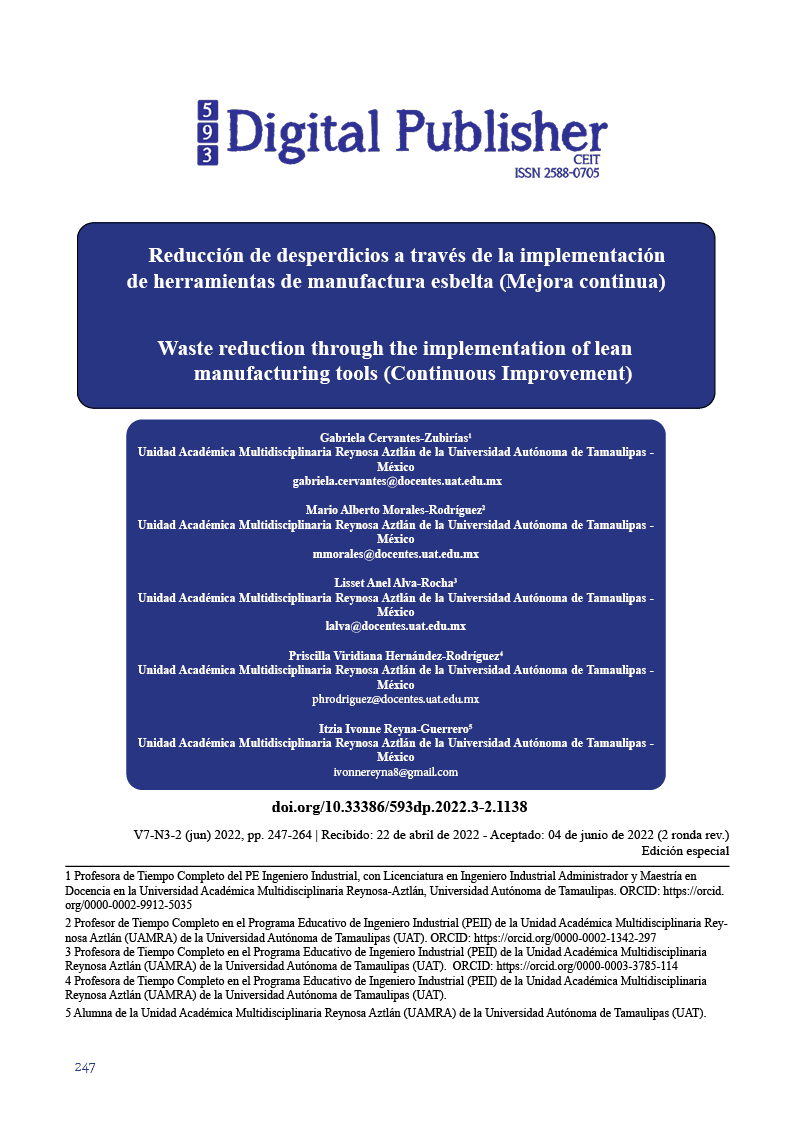Waste reduction through the implementation of lean manufacturing tools (Continuous Improvement)
Main Article Content
Abstract
The purpose of this research is to implement lean manufacturing tools such as the phases of Lean Six Sigma that are (Define, Measure, Analyze, Improve and Control) to reduce the waste generated and the variation in the number of cycles counts of rolls of components in the production process in the area of SMT (Surface Mount Technology). In the study, a sample of rolls of the D1BA and D0GA models with different nomenclatures was selected with the help of a manual scaler to take measurements considering some specifications, such as the thickness of the component, thickness of the plastic of the roll, distance between each component, inner and outer radius. Tasks were attended to meet the needs of internal/external customers to define standards, document, and update Safety, Quality and Shipping Cost (SQDC) metric programs, Document evidence, audit implementations of improvements made from 5S's methodologies, Kaizen and track progress to measure engagement and financial impact through performance charts for continuous improvement and detection of waste and standardization of work. The result allowed to assess the metrics of the project for the economic performance (Yield) before the intervention was 97% and the continuous improvement allowed to obtain 99.3% improvement, thus fulfilling the goal of 99%, with respect to the measurement of the Equipment effectiveness of the OEE (Overall Equipment Effectiveness) before the intervention 70% and after the improvement 87% with the goal achieved of 85%. Likewise, this represents a profit in the operation of 18.5% considering that before the intervention there was 10.50%, fulfilling the goal of 15%.
Downloads
Article Details

This work is licensed under a Creative Commons Attribution-NonCommercial-ShareAlike 4.0 International License.
1. Derechos de autor
Las obras que se publican en 593 Digital Publisher CEIT están sujetas a los siguientes términos:
1.1. 593 Digital Publisher CEIT, conserva los derechos patrimoniales (copyright) de las obras publicadas, favorece y permite la reutilización de las mismas bajo la licencia Licencia Creative Commons 4.0 de Reconocimiento-NoComercial-CompartirIgual 4.0, por lo cual se pueden copiar, usar, difundir, transmitir y exponer públicamente, siempre que:
1.1.a. Se cite la autoría y fuente original de su publicación (revista, editorial, URL).
1.1.b. No se usen para fines comerciales u onerosos.
1.1.c. Se mencione la existencia y especificaciones de esta licencia de uso.
References
Beristain . (2019). Control de la variabilidad de rueda dentada para maquinaria. Ingeniantes, 61-69.
Burgasi, Cobo y Perez. (2021). EL DIAGRAMA DE ISHIKAWA COMO HERRAMIENTA DE CALIDAD EN LA EDUCACIÓN: UNA REVISIÓN DE LOS ÚLTIMOS 7 AÑOS. Tambara, 4-5. Obtenido de http://tambara.org/wp-content/uploads/2021/04/DIAGRAMA-ISHIKAWA_FINAL-PDF.pdf
Cadena. (2017). Métodos cuantitativos, métodos cualitativos o su combinación. SCIELO, 4. Obtenido de http://www.scielo.org.mx/scielo.php?script=sci_arttext&pid=S2007-09342017000701603#:~:text=La%20distinci%C3%B3n%20m%C3%A1s%20obvia%20que%20cabe%20establecer%20entre,documentos%2C%20correspondencia%2C%20registros%20y%20estudios%20de%20casos%20pr%C3%A1ctico
Carlo, L. (2019). Lean Six Sigma Sistema de gestión para liderear empresas. PUCP, 1.
Carrillo. (2021). Reducción de ruido industrial en un proceso productivo metalmecánico: Aplicación de la metodología DMAIC de Lean Seis Sigma. UCP, 42-43.
Castillo. (17 de Abril de 2021). Repositorio UTP. Obtenido de Implementación de la Metodología Lean Six Sigma para reducir costos de producción en el proceso de fabricación de transformadores de baja tensión en la empresa NIUSA S.A.C.: ttps://repositorio.utp.edu.pe/bitstream/handle/20.500.12867/4685/M.Castillo_Trabajo_de_Suficiencia_Profesional_Titulo_Profesional_2021.pdf?sequence=1&isAllowed=y
García. (2020). Aplicación de metodología DMAIC en la resolución de problemas de calidad. MunduFesc. Obtenido de https://www.fesc.edu.co/Revistas/OJS/index.php/mundofesc/article/view/508
Gutiérrez y Vara. (17 de Abril de 2009). Control Estadístico de la Calidad y Seis Sigma. En H. y. Gutiérrez, Control Estadístico de la calidad y seis sigma tercera edición (págs. 2-11). México: Mc Graw-Hill Interamericana editores. Obtenido de Control Estadístico de la Calidad y Seis Sigma: https://www.academia.edu/43173897/Control_Estad%C3%ADstico_de_la_Calidad_y_Seis_Sigma
Kurnia, y Purba. (2021). Una revisión sistemática de la literatura de Lean Six Sigma en varias industrias. Revista de Ingeniería y Gestión de sistemas industriales, 9 (2), 19-30.
Mahmoud, Haddad y Musharbash. (2018). Using Six Sigma DMAIC Methodology and Discrete Event Simulation to Reduce Patient Discharge Time in King Hussein Cancer Center. Hindawi, 3-4. Obtenido de https://www.ncbi.nlm.nih.gov/pmc/articles/PMC6035855/
Medina, J. (2018). Efecto del mantenimiento industrial, maquinaria y equipo, mano de obra, métodos. ECORFAN-Perú, 34-44.
Morales, R. I. (2020). Aplicación de Herramientas Seis Sigma en la Solución de Problema de Soldabilidad. Repositorio Institucional del Tegnologico Nacional de Mexico, 135. Obtenido de http://51.143.95.221/bitstream/TecNM/1249/1/Rodolfo%20Ivan%20
Pachas. (2019). Aplicación de un programa de mejora continua utilizando Manufactura Esbelta (Lean Manufacturing) en el nivel de gestión del proceso de cartonera de la empresa la Calera en la provincia de Chincha. Universidad Ricardo Palma, 18-19.
Pérez, Hernández y Luviano. (2020). Aplicación AMEF con MOORA para la evaluación de un caso. mundo fesc, 29. Obtenido de https://www.fesc.edu.co/Revistas/OJS/index.php/mundofesc/article/view/627/589
Ramos. (2019). Optimización del análisis de falla de tarjetas electrónicas con Seis Sigma. Dialnet, 58. Obtenido de https://dialnet.unirioja.es/servlet/articulo?codigo=7082358
Rosales y Moreno. (2020). Implementación de la herramienta AMEF para reducir mermas en la producción de textos escolares Editorial Bruño, Ate Vitarte 2020. Repositorio UCV, 18. Obtenido de https://repositorio.ucv.edu.pe/handle/20.500.12692/63150
Salcido. (2021). Diseño e implementación de un sistema de buenas prácticas, para la introducción exitosa de un nuevo producto automotriz en el departamento de ingeniería. ITESO, 88. Obtenido de https://rei.iteso.mx/bitstream/handle/11117/7702/TOG%20FINAL%2026-11-2021%20PISS.pdf?sequence=1
Sanchez. (2020). Google libros. Recuperado el Marzo de 2022, de ANÁLISIS FODA O DAFO El mejor y más completo estudio con 9 ejemplos prácticos: https://books.google.com.mx/books?hl=es&lr=&id=6h0JEAAAQBAJ&oi=fnd&pg=PT10&dq=implementacion+del+dafo&ots=8ZPlRhisAh&sig=OzWpdso1hzqJkFYkfCs9XwXG4NY#v=onepage&q&f=false
Socconini y Escobedo . (19 de marzo de 2021). Lean Six Sigma Black Belt Pasoa Paso Marge Books. Obtenido de Lean Six Sigma Black Belt Pasoa Paso Marge Books: https://www.academia.edu/40610819/Lean_Manufacturing_Paso_A_Paso_Luis_Socconini_pdf






 .
.